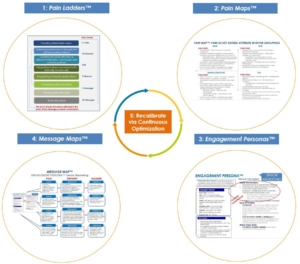Advisor Pains — Urgent, Visible Problems
To understand an advisor’s point-of-view and to engage with them, you must have a deeper understanding of their pain — their urgent, visible problems, even those they may not be aware of. From a high level you might generalize their pains as:
- Differentiating themselves from their competitors
- Justifying their fees and navigating an accelerated shift from commission-based to fee-based accounts
- Attracting broader demographics and segments
- Adapting their behavior, digital tools and agenda to their clients’ way of life.
However, this is likely too generalized to your total market. For example what are the comparative pains of indy advisors vs. wirehouse advisors vs. independent advisors/RIAs – as well as for the major segments within each.
Pain Maps – Foundation of Advisor Engagement
There are four interdependent and sequential elements or building blocks that make up an effective Advisor Engagement Strategy. It is likely no surprise that pain points are the foundational element.

Illustrative
-
- Pain Maps™
- Engagement Personas™
- Pain Ladders™
- Message Maps™
Organizing advisor pain points in Pain Maps™ will enable the ULTIMATE goals of creating Engagement Personas™ and informing the message development process. Engagement Personas™ should represent an excellent buyer-centric perspective and be rich with pain points relative to your solutions.
Further, it is important to organize and prioritize the pain points for each segment (e.g., RIAs, Wire Houses, Indys) in order to connect them to the larger narrative in the context of segment-specific demand engagement initiatives. As you go through this process, you’ll see there’s often overlap between segments/buyer types, thus allowing for the most efficient message, experience and content development processes possible.
For example, an Independent persona’s pain points may contrast as well as overlap with a wirehouse advisor as illustrated below.
Illustrative Pain Points
Independent Advisor
- Fund companies that don’t understand me or my business
- Need insight and perspective that can be used with clients
Wirehouse advisor
- Help positioning alternatives and “unconstrained” funds
- Keeping up on products and the markets
Independent / Wirehouse Advisors
- Portfolio advice / 2nd opinion
- Broadening client demographics
Both Pain Maps™ and Engagement Personas™ are created through interviews with key stakeholders, primary and secondary research, surveys and, most importantly, interviews with your target audience.



